

| Electro Flying In A Smaller Way!! |
Welcome back to Electro Flyer and another months modelling updates. I had a week away at the start of the month so there is not quite so much to cover this month, but I will probably rabbit on anyway!
If you missed last months issue then you really should find it as it covered my Electric Team Gear powered 84" span Radio Queen which is still giving me immense pleasure and superb long flights … and of course, after a months flying, she is still clean and immaculate .. another great benefit of electric flying.
Last month I mentioned the two tiny Spitfires I had obtained. The Testors Cox powered one has been bench run but needs a little running through to clear out years of gunge before she takes to the air.
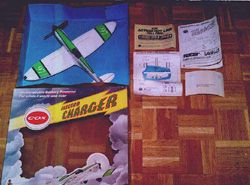 Strip
Down & Full Check
Strip
Down & Full Check
The Electric Cox version has been stripped down for a full check up. She
is pretty much new but due to her age the rechargeable battery(s) are
missing and I am looking for suitable ones to go in her .. six volts in
total but only about the size of a sub C cell .. I'll keep looking and
hopefully will be able to report on this little control liner next month.
There is a photo her to give you an idea.
C of G Outside The Airframe!
My main project this month has been a Speed 400 powered vintage 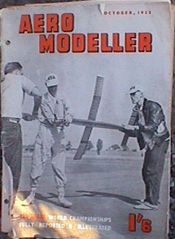 model
(as mentioned last month). This is a 44" pusher model called the
"Pushy Cat" and designed as a free flight model by Vic Smeed
back in the early 50's. At that time it won the Bowden Trophy. I came
across this design many years ago after being given some old Aeromodeller
magazines and there it was in the October 1953 one .. cover shown left.
model
(as mentioned last month). This is a 44" pusher model called the
"Pushy Cat" and designed as a free flight model by Vic Smeed
back in the early 50's. At that time it won the Bowden Trophy. I came
across this design many years ago after being given some old Aeromodeller
magazines and there it was in the October 1953 one .. cover shown left.
A snip at one and six. There was a short review of the model and it was so unusual I just fell in love with it, it's unusual technical features also appealed.
The odd thing with this model is that it does not have a centre of gravity
inside the airframe !!!!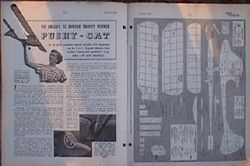
Here is what appeared in the magazine. (See right)
The lady holding it is Margaret, Vic Smeed's wife. The dihedral equals the sweep back on the wing so in the picture above it gives the illusion that it has a flat wing. The tail plane is half as big as the wing, there is a boat load of incidence on the main wing and combined with the sweep back, dihedral and strange shape, the C of G is actually just under the centre of the engine where the curved rear cowling is … hence, not in the airframe at all.
This fascinated me as my knowledge of models says that as a general rough guide you can balance a model 1/3 of the way back from the leading edge and it should be OK. This one actually balances about an inch and a half behind the trailing edge of the wing .. Strange!
Still, I though to win a Trophy it must work so I set about how I was going to convert this to electric. I scaled the plans up to full size and got all my electrics and radio to lay them on top and see where it would all go.
Tight Squeeze
With a maximum body width of hardly anything it was all going to be a
tight squeeze. Just wide enough for a mini Hi-Tec receiver but only one
mini servo if the arms were going to have their own space.
Finally, I ended up with a micro servo right at the tail which was to have a direct piano wire push rod to the elevator (which was the trailing edge of the original), the rudder servo at the rear of main body part with a snake pushrod, then the receiver vertically in from of that and the battery pack vertically in front of that .. and that was all the room there was.
I used a speed controller that fits directly onto the back of the speed 400 and this just fitted into the original location of the engine (which was a Mills .75) and allowed for it to be faired in.
As almost all of the components had to built into the model during construction
I soldered the battery lead extensions and the servo extension lead for
the elevator servo. Lets hope nothing breaks down as it won't be easy
to replace anything.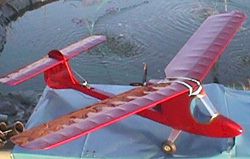
Construction is fairly straight forward, just the wing joining being tricky as it has dihedral and sweep back. I epoxied the tail plane in place as I felt the servo movement could displace it, plus, if it did move then it would move the elevator which I didn't fancy!
Untraditionally I covered it in metallic deep red Solarfilm, I just like that colour! The batteries are a 7 sub C cell pack and the prop is a Graupner 6x3 4 blade pusher.
So here she is .. another speed built model to give me more to write about. (See right)
Based On Full Size Of The Day
You can just make out the servo and push rod at the rear in this shot.
She really needs a pilot and I may be working on this in the future ..
from foam of course .. to save on weight. T he
original weighed in at about 11oz. I managed to complete this one weighing
in at 20oz, not too bad considering the gear that is in it. I may change
to piano wire undercarriage and lightweight wheels if I feel it needs
it.
he
original weighed in at about 11oz. I managed to complete this one weighing
in at 20oz, not too bad considering the gear that is in it. I may change
to piano wire undercarriage and lightweight wheels if I feel it needs
it.
She is an odd looking beast but was based on full size aircraft of the day, the "Scheldemeuw" and the "Carden-Baynes" the article says.
Does It Fly?
So, now the important bit .. does she fly? Well, she had plenty of power
and taxi tests on the drive proved that, but I did not have the luxury
a tarmac runway so it was going to have to be a hand launch. Off I went
to my flying site, fully charged and heart in mouth. Full power and a
gentle chuck into wind.
Off she went, quite a steep climb, so a little bit of down to hold her steady. A slight cross wind caught her so a little rudder to compensate .. then the fun began!
Does Not Conform To The Standard R/C Rules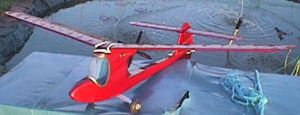
Basic modelling theory and techniques or not, this does not conform to
the standard R/C rules. The lovely amount of incidence I referred to earlier
is great for free flight but does not appreciate being controlled. I had
three flights with her to fully check this out and develop what needed
changing for proper R/C operation and I hope the following will be of
help to people considering a similar conversion.
Firstly, the large angle of incidence fights against control .. left alone she flies beautifully, but make her turn and she does not like it! On the third flight I slipped a 1/8" piece of ply under the trailing edge of the wing and that helped a lot. Secondly, the engine thrust line was not now in line with the wing giving effective down thrust directly across the high flying tail plane and I felt this affected things as well. Thirdly, on close inspection I found that the shrinking of the Solar Film on the wings had produced more washout (rear of the wing tip pitched up relative to the rest of the wing - which is a good thing) in one wing than the other causing a slight corkscrew effect which makes the model want to turn in one direction more than the other.
Finally, I felt that the relatively weak tailplane to fin fixing allowed a slight movement of the tailplane when the elevator servo was moved .. I also felt the elevator needed more surface area for full control.
Controllable Fun Machine
So, an extra wing fairing was made to give a different angle of incidence,
the tailplane has flying wires fitted to prevent any movement, the engine
pitch was changed and a little extra shrinking on the top of the one wing
pulled the washout back into equality with the other side. I then doubled
up the elevator size to be on the safe side. All of this was only an hour
or so's work but I felt it was worth it to achieve what I had set out
to do .. get a really controllable fun machine that I could fly anywhere.
During my initial test flights I did realise that my weight worries were not founded as it could quickly get up to about 100 feet and glide in a gentle breeze almost forever .. so I knew I had a winner. Fortunately my reactions are pretty fast and so all flights ended with a deceptively good landing and no damage done.
All the modifications have been done but time and the weather have prevented further flights. I will give a full update next moth, unless I can talk the ED into squeezing an update in as soon as I have one. I am, however, confident that things will be fine now and that she will be a real treat to fly … then she will come to fly in my back garden as was originally intended … fantastic!
Next Project
I am working on a single engined version of my Team Gear units for smaller
models. This won't be as cheap as the plastic ones out there but should
be far more efficient and I will report on this, any updates on the Radio
Queen and Pushy Cat next month.
I am contemplating putting the single engined team Gear unit into my "Butterfly" trainer parasol type model .. it seems about the right size for this - but no final decision yet.
My latest brainwave, and I never stop thinking and planning models, just can't help it - I love modelling - is a Team Gear powered parachute. These are known as Sky Surfers in the full size world - and GCon did a little electric one called just that which may help visualise what I have in mind … just scale it up A LOT and increase the flying time by a few factors .. if successful it should be a real all rounder for all age groups and levels of experience as well as the perfect test bed for slow steady aerial photography.
I still have a 60" Span American/Canadian style kit to build called the "Custom Cruiser" which will be powered by a Team Gear Mini Twin unit but I don't think that that will be done before the next article … still plenty to do in the mean time and I will keep you posted on anything new.
Of course if any of you have questions, or any suppliers have products they would like testing and reviewing then please get in touch and I will try and oblige .. I still have some room for more models and I just love building .. now, what shall I do with that set of four Bae 148 ducted fan electric motors that are sitting on the bench?.. suggestions welcome!
Thanks for reading and please do give feed back, either to myself or the editor .. if you like my articles they might just keep me busy and hopefully my experiences are of benefit to others.
If you have any questions then please get in touch with
Mark at:
ratby@bizonline.co.uk
or check out his web site at:
www.bizonline.co.uk/ratbyaeroplanes